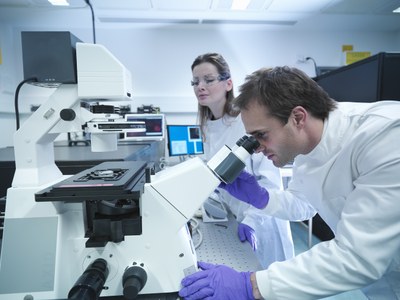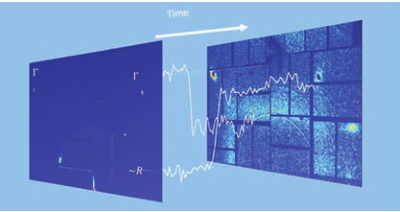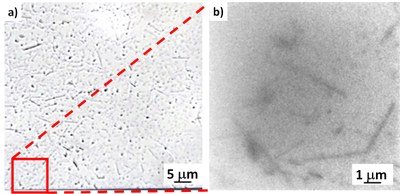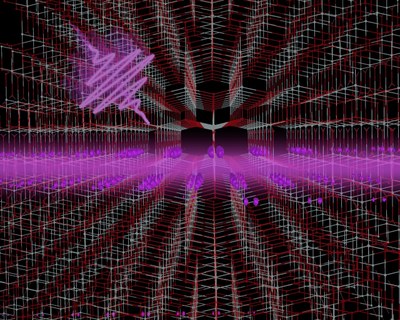Lasers for Materials Science
Lasers can be used to study or manipulate materials in many different ways. This focus shows how researchers from several of Laserlab-Europe’s partners are involved in laser-based materials science. The highlighted projects include diagnostic application of lasers, such as extreme ultraviolet light for ultraprecise microscopy, spectroscopy of photoactive materials, fluorescence imaging of a range of materials, and laser-assisted imaging of a material’s magnetic field. Another contribution shows how ultrashort, high-power laser pulses can be used to study phase transitions in solids. More directed at the manipulation of materials are accounts on photolithographic fabrication of nanorods and precision laser ablation, as well as on the mechanisms behind the ablation process. These examples illustrate the variety of techniques for materials science within Laserlab-Europe, which are available for users from outside the consortium via the transnational access programme.
Laser-based fluorescence microscopy for materials science (CLF, UK)
 |
|
Researchers in the Octopus lab at the Central Laser Facility |
The Octopus microscopy cluster at the UK’s Central Laser Facility (CLF) offers most laser-based fluorescence microscopy techniques to the user community. Recently there has been increased interest from the physical sciences community in these traditionally biological imaging methods, promoted by the interdisciplinary environment of the facility in the Research Complex at Harwell (RCaH).
Recently, a research group led by Prof. Fiona Meldrum from Leeds University investigated the incorporation of organic additives into crystalline materials [1]. These additives are often used to control the crystallisation process. This work used a combination of scanning electron microscopy and X-ray diffraction to show the location of the occlusions and their effect on crystal morphology, while fluorescence spectroscopy and lifetime imaging on Octopus was used to probe the local environment of the occlusions within different zones of the crystal. The strategy was then extended to incorporate simultaneously mixtures of dyes, whose fluorescence cascade creates calcite nanoparticles that fluoresce white. This offers a simple strategy for generating biocompatible and stable fluorescent nanoparticles whose output can be tuned as required.
The location of the UK Catalysis Hub in RCaH has prompted a number of interactions with the CLF, including use of Octopus. In a project led by Prof. Andrew Beale (University College London/RCaH) [2] again a combination of X-ray and optical microscopy was used to investigate a physical sciences system. This work showed how molybdenum speciation and hydrocarbon accumulation affect the performance of catalysts used in the conversion of methane into high-value chemicals.
The final example is in the use of super-resolution imaging techniques for the characterisation of advanced materials. A study headed by Ian Manners (Bristol University) [3] used a combination of X-ray spectroscopy, electron microscopy, and super-resolution fluorescence microscopy to study platelet micelles. These structures are built from block copolymers and the solid and hollow 2D micelles provide a tunable platform for further functionalization and have potential for a variety of applications. We expect continued growth in the use of these techniques for physical sciences research. The interdisciplinary nature of RCaH and its colocation with facilities offering complementary techniques makes it well placed to make the most of these developments.
Dave Clarke
[1] D.C. Green et al., Nature Communications 7: 13524, 2016
[2] I. Lezcano-Gonzalez et al., Angew. Chem. Int. Ed. 55: 5215, 2016
[3] H. Qiu et al., Science 352: 697, 2016
Laser-made 3D zinc oxide nano- structures (IESL-FORTH, Greece)
| Scanning Electron Microscope images of a zinc oxide nanorod- coated 3D structure of blocks (center), fabricated with Multi- Photon Lithography and zinc-seeded aqueous chemical growth. Reproduced from Giakoumaki et al. 2017 |
Fabrication of 3D zinc oxide (ZnO) nanostructures is important for the development of novel ZnO-based devices, such as photocatalysts. Researchers from IESL- FORTH (Crete, Greece) have recently demonstrated that complex patterns of three-dimensional ZnO nanorods can be made combining nanolaser techniques with low-temperature hydrothermal growth.
Zinc oxide (ZnO) is a widely-studied metal oxide semi- conductor, due to its potential use in a variety of applications, such as gas sensors, photocatalysts, nanolasers, photo-electrochemical cells for hydrogen generation from water splitting, and photoluminescent devices. Its useful properties, but also the various geometries that can be grown, such as nanorods and nanobelts, make it one of the most studied materials in nanoscience. For the fabrication of pure and doped ZnO nanostructures, several chemical and physical synthesis methods have been adopted to control the distribution of ZnO nanostructures on mainly flat surfaces.
At IESL, researchers have recently developed an innovative method for the fabrication of fully 3D ZnO nanorod-coated structures, which involves seeded hydrothermal growth of ZnO nanorods on a 3D scaffold of an organic-inorganic hybrid material, fabricated by Multi-Photon Lithography (MPL). The growth of ZnO nanorods is based on a two- step procedure that requires the deposition of a metallic zinc seed layer onto the polymeric scaffold, employing the pulsed laser deposition (PLD) technique, followed by an aqueous chemical growth of ZnO nanocrystalline rods out of an aqueous solution of zinc nitrate hexahydrate (Zn(NO 3 ) 2 ) in the presence of ammonia.
This is a straightforward and flexible scheme carried out at relatively low temperature (<100o C), and is consistent with different types of substrates. Additionally, the laser-based techniques employed for the fabrication of 3D scaffold (MPL) and the seed Zn layer (PLD), allow the deposition of ZnO nanorods in the form of micro-architected patterns on substrates with flat or complex geometry. Additional variability in the nanorod structure architecture can be introduced by varying the growth conditions, while the incorporation of appropriate chemicals would enable the growth of doped or functionalized ZnO nanorods.
Maria Farsari and Argyro Klini
A.N. Giakoumaki et al., Scientific Reports 7: 2100, 2017
A new look at ultrafast phase transitions (ICFO, Spain)
 |
|
Evolution of the diffuse scattering during a photoinduced phase |
Researchers from the Ultrafast Dynamics of Quantum Solids group of Dr. Simon Wall at ICFO, Barcelona, Spain, in collaboration with groups at the Pulse Institute at SLAC and Duke University in the USA, have used free electron lasers in the USA and Japan to watch the femtosecond dynamics of a phase transition in a new way.
Phase transitions in solids can be studied using Bragg reflection of X-rays, which reflect from samples at specific angles due to constructive interference between planes of ordered atoms. The higher the crystallinity, the sharper and more intense the reflectivity, or Bragg peaks, appears.
If a phase transition occurs, some symmetry planes may be lost, resulting in a change in the number and position of the Bragg peaks. Researchers now routinely exploit this fact to measure how phase transitions occur in real time. Femtosecond pulses of light are used to trigger a phase transition and the intensity of the Bragg peaks are monitored with pulsed X-ray sources. However, whilst this technique measures the timescale of phase transitions, it does not reveal how the transition occurs. To overcome this limitation the researchers used time-resolved thermal diffuse scattering (TDS) of the structural transition in vanadium oxide (VO2 ). This technique measures the inelastically scattered X-rays from a sample, which is typically orders of magnitude weaker than the elastically scattered X-rays, but is sensitive to the displacements of the atoms from their average positions. With the development of ultrafast and ultrabright X-ray free electron laser sources this signal can now be measured in the time domain.
The TDS signal showed that, while the lattice initially makes a cooperative motion after photoexcitation, within 60 femtoseconds atomic motions become random, which ultimately drives the phase transition. The ultrafast nature of this transition from coherent to incoherent motion provides a new interpretation of the phase transition in terms of rapid transfer of energy between vibrational modes of the system, and points to strong anharmonicity as a mechanism for providing the rapid switching time.
Simon Wall
Extreme ultraviolet (EUV) microscope for imaging of nanostructures (MUT, Poland)
 |
| Images of the silver nanowires obtained for comparison between a visible light micrograph, obtained with a NA = 0.7, 40´ objective (a) and the EUV microscope (b). To acquire the EUV image, 200 EUV pulses were accumulated, at a 10 Hz source repetition rate. In the images nanowires with variable lengths and thicknesses of the order of a fraction of a micron can be observed. Reproduced from Torrisi et al. 2017. |
A compact, desktop-sized microscope, based on a laser-plasma light source and a diffractive Fresnel zone plate objective, was devel- oped by Polish Laserlab- Europe partner IOE- MUT. The microscope operates in the extreme ultraviolet (EUV) region at the wavelength of 13.8 nanometre, and has been used for imaging of silver nanowires.
Progress in materials science, especially in nanoscience and nanotechnology, requires improvement of the spatial resolution of microscopes in order to obtain images on the nanometre scale. Light of shorter wavelength can be focused into smaller volumes, improving the diffraction limited resolution and allowing to see finer details. Imaging with radiation in the extreme ultraviolet (EUV) spectral range (10 to 121 nm) has been demonstrated using various light sources, including synchrotrons and free electron lasers (reaching a spatial resolution of ~10 nm), as well as light sources based on plasmas and high-order harmonics generation (yielding sub-100 nm resolution).
Researchers from the Institute of Optoelectronics-Military University of Technology (IOE-MUT) have now developed a compact, desktop-sized microscope using a laser- plasma EUV source and Fresnel optics. The source is based on an argon gas puff target irradiated with nanosecond pulses from a commercial Nd:YAG laser. The microscope is operating at the wavelength of 13.8 nm, which is selected from the argon plasma emission using an ellipsoidal off- axis collector with Mo/Si multilayer coating. EUV-illuminated samples are imaged in transmission mode onto a CCD camera using a Fresnel micro-zone plate. The spatial resolution obtained from measurements performed using a well-established ‘knife-edge’ test was about 95 nm.
The EUV microscope was used for imaging of silver na- nowires deposited on top of a 30 nm thick silicon nitride membrane. The nanowires, with a diameter in the range of 10-100 nm and a length of a few micrometers, were syn- thesized using CuCl2 -mediated polyol process. The EUV image exhibits superior spatial resolution and much higher optical magnification (410´) compared with a visible light micrograph.
Henryk Fiedorowicz and Przemyslaw Wachulak
A. Torrisi et al., Journal of Microscopy, 265: 251, 2017
Pulse shaping for improved femtosecond ablation (IST, Portugal and CLPU, Spain)
| Two-dimensional map of the depth profile of holes in copper. The colour scale shows depths in micrometres. Number of shots ranging from 10 to 5000 and energy from 25 μJ to 2.7 mJ. |
Over the past two decades, femtosecond laser pulses have been used for probing delicate living structures without damaging them, or for high precision microprocessing of high quality materials on the micro- and nanoscale. Researchers at IST in Lisbon and CLPU in Salamanca have now teamed up to study the ablation by custom- shaped pulses on metallic and organic targets.
Laser ablation is a material processing technique that has undergone a number of technological advances in re- cent years. The use of extremely short (femtosecond level) laser pulses is at the forefront of many fundamental applications, as shorter driving laser pulses lead to a higher quality material processing.
The laser teams in Lisbon and Salamanca, led by Dr. Gonçalo Figueira and Dr. Mauricio Rico, respectively, have joined their efforts and experimental capabilities in a new collaboration. Their goal is to investigate the mechanism of ultrafast laser ablation for biological applications by employing simultaneous spatial and temporal shaping of the laser beam. This technique holds the potential to significantly improve the efficiency of the process, contributing to a better understanding of the material processing meth- ods at such extreme timescales.
The Portuguese team has developed an automated experimental setup for spatial shaping of the laser pulse. Preliminary studies were concentrated on metals because of their homogeneous structure and well known properties. Additionally, copper and teeth samples were tested.
The main results from this ongoing work are the de- termination of the thermal threshold fluence – the laser energy density at which the target is vaporized – for two significantly different types of materials (organic and metallic), in the femtosecond pulsed regime. The conditions for micro-crack formation and strong damage induced to the surrounding material were also found. Besides these achievements, the depth profiles of ablated holes and lines and their dependence on fluence were studied.
The collaboration with CLPU arose from the expertise developed by this team in several aspects of laser ablation, namely the sample preparation, interaction and analysis. IST researcher Victor Hariton acquired practical know-how at their facilities in the scope of a Laserlab-Europe staff exchange grant. The next goals include developing the temporal pulse shaping setup in order to evaluate the ablation rate and compare the results with analytic calculations.
Victor Hariton, Mauricio Rico and Gonçalo Figueira
Mechanisms of laser-induced ablation in dielectrics (SLIC, France)
Femtosecond lasers can be efficiently used to drill, ablate, cut, or to permanently modify – in three dimensions – the optical properties of transparent materials, giving rise to numerous applications. Improving laser processing requires a detailed knowledge of the physical mechanisms involved during the interaction. To get more insight in this complex situation, experiments have recently been carried out on silica and sapphire at SLIC, Saclay.
Understanding the physics underlying laser damaging, breakdown, or processing of wide band gap dielectrics, is a challenging task due to the competition between many different elementary physical mechanisms, all occurring at sub-picosecond or femtosecond time scale: electron-phonon interaction, elastic and inelastic electron-electron scattering – including impact ionization, formation of transient or permanent defect states, exciton self-trapping, exciton-exciton interaction, etc.
Recently, in a transnational access project, experiments have been carried out in Saclay (SLIC facility) on silica (SiO2) and sapphire (Al2O3) samples, in collaboration with two teams from Aarhus University (Prof. Peter Balling) and Madrid (Prof. Javier Solis). Modification of the optical properties of the surface and the bulk was measured simultaneously using time-resolved reflectivity and Fourier-transform interferometry, at pump intensity up to three times the ablation threshold, over a temporal span of 300 picoseconds. The main outcomes of these investigations are the following: For both materials, silica and sapphire, and for fluences well above the ablation threshold, the maximum measured plasma reflectivity shows a saturation behaviour. Our numerical simulations show that in this high fluence regime, for the pulse duration used (120 fs FWHM), collisional excitation dominates over strong-field excitation. This causes a cooling of the conduction band electrons down to the Fermi velocity limit, where the carrier-carrier scattering rate becomes proportional to the density of free electrons. As a consequence, the reflectance of the excited surface becomes nearly constant according to the Drude- Lorentz model.
Finally, in the temporal window of 10–30 picoseconds, both materials simultaneously display low reflectivity (close to zero) and high absorption (close to one). This suggests that, before the excited region substantially expands or exchanges heat with the surroundings, the material transiently behaves optically like a high-temperature blackbody.
Stéphane Guizard
M. Garcia-Lechuga et al., Phys. Rev. B 95, 214114, 2017

Image of reflected probe beam at the surface of a-Al2O3, for different time delays.
Magnetic field imaging using nitrogen-vacancy centres in diamond (ULLC, Latvia)
| By sweeping the frequency of an applied microwave field and monitoring the fluorescence of the nitrogen-vacancy centres, the Optically Detected Magnetic Resonance (ODMR) spectra and thus the magnetic field can be retrieved. Doing this on a pixel by pixel basis and performing a numerical fit to a Gaussian function, a magnetic image for 4 μm diameter magnetic particles can be obtained. |
A recent study by a team from the Laser Centre of University of Latvia (UL LC) shows that magnetometry based on nitrogen-vacancy centres can be used to create microscope-like images of the magnetic field of small magnetic particles, with unrivalled spatial resolution. With the advent of inexpensive high-power green diode lasers, this magnetometry method has now become an inexpensive imaging tool.
An image of the magnetic field distribution can offer in- sights beyond what could be obtained purely through optical microscopy when dealing with paramagnetic materials. Magnetotactic bacteria, magnetorheological materials or magnetic labelling materials all have magnetic features of micrometre scales. However, magnetic measurement devices based on alkali metal vapour cells, SQUIDs or Hall probes either lack the spatial resolution to discern the tiny features or their operating conditions are such that close proximity could adversely affect the sample.
As part of Laserlab-Europe’s Joint Research Activity PHOTMAT, researchers from ULLC studied nitrogen-va- cancy centres in diamond as a tool for magnetic imaging. Nitrogen-vacancy centres are point defects in the lattice of diamonds, where two nearest-neighbour carbon atoms are replaced by a nitrogen atom and a hole (vacancy). This produces an atom-like colour defect in a triplet spin state, which can be polarized and read out optically. The defects are commonly formed by ion implantation and annealing, allowing one to engineer a diamond chip with nitrogen-vacancy centres 100 nanometres beneath the surface, ensuring close proximity between the sensor and the sample.
Using a combination of optical pumping with a green laser and an applied microwave field, the local magnetic field inside the diamond chip, as produced by small magnetic sample particles placed on its surface, can be deduced from the spatial variation of the fluorescence emitted by the nitrogen-vacancy centre in a method called Optically Detected Magnetic Resonance.
The purpose was to obtain images of magnetic field distributions for particles whose magnetic moment have been measured by other means, and to compare these measurements to the values obtained from the magnetic field images. The ULLC researchers were able to detect particles as small as 19 nanometres, though the optical res-olution is still diffraction limited (~500 nm). They conclude that while the imaging method is definitely less sensitive than vapour cell or SQUID-based techniques, the spatial resolution obtained using nitrogen-vacancy centres is unrivalled.
Jānis Šmits
J. Smits et al., Eur. Phys. J. Appl. Phys. 73: 20701, 2016
Light absorption by titanium dioxide (LACUS, Switzerland)
 |
| Lattice structure of anatase TiO 2 with a graphical representation of the 2D exciton that is generated by the absorp- tion of light (purple wavy arrow). This 2D exciton is the lowest energy excitation of the material. © Joerg Harms |
Scientists from Swiss Laserlab-Europe associate partner Lausanne Centre for Ultrafast Science (LACUS) have uncovered hidden properties of titanium dioxide, a promising material for light conversion technology. Using a range of laser-spectroscopic techniques, an international collaboration led by LACUS professor Majed Chergui found that light energy is stored in this material in the form of bound electron-hole pairs (called excitons), confined in two dimensions.
Titanium dioxide (TiO2) appears in different crystalline forms and its “anatase” polymorph is today one of the most promising materials for a wide range of applications, ranging from photovoltaics and photocatalysis to self-cleaning glasses, and water and air purification. All of these are based on the absorption of light and its subsequent conversion into electrical charges.
The LACUS collaboration has now discovered that the threshold of the optical absorption spectrum is due to a strongly bound exciton, which exhibits two remarkable novel properties: First, it is confined on a two-dimensional (2D) plane of the three-dimensional lattice of the material. This is the first such case ever reported in condensed matter. And secondly, this 2D exciton is immune against temperature and defects as it is present in any type of TiO2 – single crystals, thin mesoporous films, and even nano-particles used in devices.
This “immunity” of the exciton to long-range structural disorder and defects implies that it can store the incoming energy in the form of light and guide it at the nanoscale in a selective way. This promises a huge improvement compared to current technology, in which the absorbed light energy is dissipated as heat to the crystal lattice, making the conventional excitation schemes extremely inefficient. Furthermore, the properties of the newly discovered exciton are very sensitive to a variety of external and internal stimuli in the material (temperature, pressure, excess elec- tron density), paving the way to a powerful, accurate and cheap detection scheme for sensors with an optical readout.
To uncover these peculiar properties of TiO2, the team used steady-state angle-resolved photoemission spectroscopy (ARPES), which maps the energetics of the electrons along the different axis in the solid; spectroscopic ellipsometry, which determines the anisotropic optical properties of the solid with high accuracy; and ultrafast two-dimensional deep-ultraviolet spectroscopy, used for the first time in the study of materials, along with state-of-the-art first-principles theoretical tools.
Edoardo Baldini and Majed Chergui

